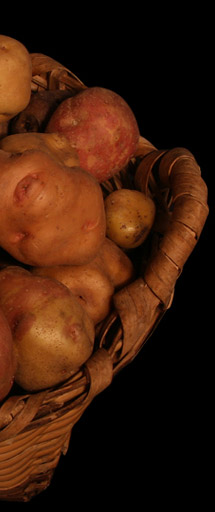
 |
 |
 |
The potato in the Canarian economy From its adoption by the canarian farmers from the XVII th century to the first quarter of the XVIII th century, the potato was a subsistence cultivation, with a very small production for exportation. The increase of surface dedicated to cultivation always coincided with the crises of export cultivations. Thus, the sugar cane crisis in the end of the XVI th century, owed to the introduction of West Indian sugar in European markets, was accompanied of an important increase of the surface dedicated to potato and maize. The decadence of the viticulture sector at he end of the XVII th century, meant a second expansion of the potato cultivated area. With the decrease of cereal production, after the wine market break, the potato crop increased again from 1826. The production exceeded some 19.000 metric tons in 1776, to 35.000 metric tons in 1830 (Macías, 1989). That is, the agriculture of subsistence, historically articulated to the export agriculture, acquired bigger intensity in the stages of recession of export cultivation. In the 1830ies, with covered local demand, the generated surplus began to be exported. It is difficult to set the point the potato exceeded to be a subsistence crop to be a part of export cultivations, but it doesn't seem venturesome to specify the second half of the XIX century, agreeing with the great expansion of cultivation, as the starting point of an important exportation. Although, in his beginnings, the American market was the main destination of the exports of certain size since late XIX th century, to the 1980ies, the British market was the principal receiver of Canarian tubers. The United Kingdom supplied the seed of the most demanded potato varieties by the English consumer. So the Islands, principally Gran Canaria and Tenerife, they grew it and exported to that market. It was eminently a colonial agriculture. Besides seeds, the fertilizers and all necessary stuff to prepare the shipments (mob, wires, nails, paper) was sold by the English to the Islands. During the XX th century, the surface dedicated to the cultivation surpassed 6.000 hectares in 1931, 12.000 hectares in 1945 and 21.000 hectares in 1960. But since 1980, with the loss of the British market due to the competition with other producers, the exportation began to descend, to disappear completely, so local production had to be guided toward local market. At present, with the opening of international markets and abolition in 1998, of the sensitive period (that preserved the local production from imports of 3 rd countries), this market is also endangered. It's in this surround where, among another alternatives, it takes sense the cultivation of local potato varieties, protected by a Certification of Origin. Source:
|
 |